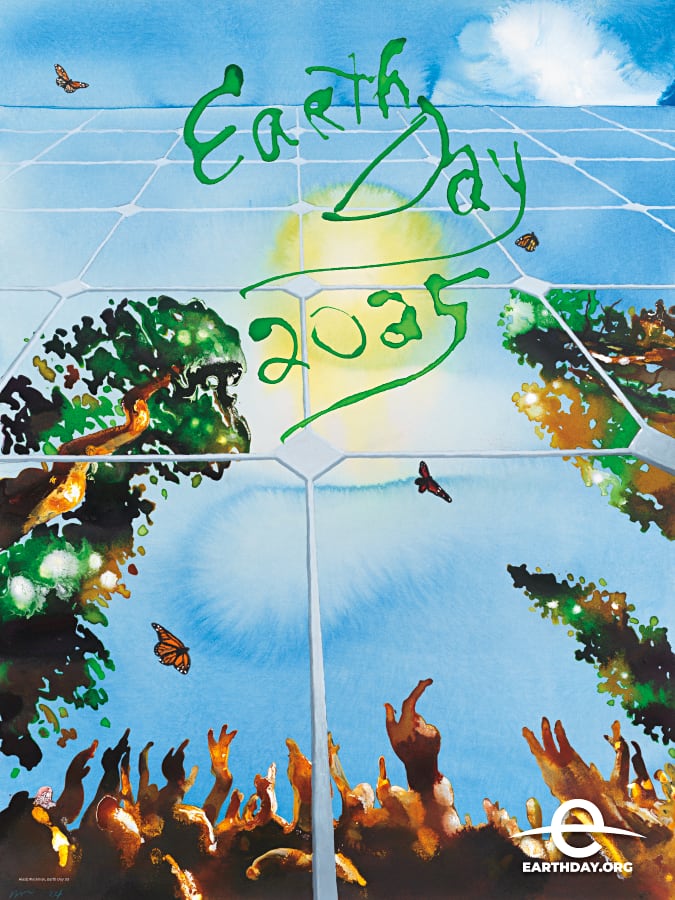When Earth Day began in the 70s, the purpose was to celebrate environmental movements and raise awareness and education surrounding the topic of the Earth’s natural resources. In 2024, as we face climate change, pollution, toxic spills, dwindling rainforests, and a threat to animals and their natural habitats, we need awareness now more than ever. The theme of Earth Day 2025 is Our Power Our Planet with a focus on calling for everyone to unite around renewable energy so we can triple clean electricity by 2030. In addition to this, each year the commitment focuses on planting trees, voting for earth, cleaning up globally, and focusing on sustainable fashion. The issue that has been building for some time now is, like many other holidays or dedicated days, companies and brands have used Earth Day as their chance to drive lavish marketing agendas and push products and services that don’t actually do much to help the environment.
In response to this, you have probably heard of the term “Greenwashing,” especially amidst the recent EU & UK Rules and Regulation changes. Movements like the Greenwashing Directive is aiming to curb misleading information and claims, brands and companies will now face more scrutiny and, in some places, even fines in an effort to protect the consumers. By 2026, terms like "climate neutral" or "eco-friendly" will require robust evidence, and companies making generic or vague claims will face penalties. To give you a bit of background to help you make informed decisions as a consumer — we’re breaking down common terms spotted around Earth Day and advice on what you can do instead.
Common Green & Clean Beauty Terms
1. Greenwashing
When brands or products exaggerate or falsely promote their environmental benefits to appear more eco-friendly than they truly are. This includes vague claims like "eco-friendly" or "natural" without transparency or certification to back them up.
2. Greenhushing
Some companies, worried about criticism or legal risks, choose to stay quiet about their sustainability efforts—even when they’re genuine. This silence prevents open conversations and reduces accountability in the industry.
3. Greenwishing
A newer term that describes when a brand sets bold environmental goals, but doesn’t have a concrete plan to achieve them. It's not necessarily deceptive, but often lacks follow-through and measurable progress.
4. Greenshifting
This happens when companies push the blame for environmental damage onto consumers. Instead of changing their own practices, they suggest it's entirely up to individuals to shop better, recycle more, or reduce their carbon footprint.
5. Un-Hushing
The opposite of greenhushing. Brands are encouraged to share both their wins and their struggles around sustainability. This shift toward openness and honesty builds trust with consumers and encourages industry-wide learning.
6. Carbon Footprint
Refers to the total amount of greenhouse gases released into the atmosphere as a result of an action, product, or lifestyle. This includes emissions from production, transportation, usage, and disposal. In 2025, there's a growing focus on verifying these numbers and holding companies accountable for reducing—not just offsetting—their footprint.
The Top Greenwashing Claims
1. Sustainable
To truly be “sustainable” in 2025, products must deliver environmental benefits without compromising the future. This includes ethical sourcing, renewable or regenerative materials, low-impact production methods, and full life cycle responsibility—from creation to end-of-life. New in 2025: Watch for brands using vague terms like “eco-conscious” or “planet-friendly” without certifications or third-party verification.
2. No Carbon Footprint / Carbon Negative
“No carbon footprint” or “carbon neutral” typically means that emissions are offset through credits or carbon capture. “Carbon negative” means a product or activity removes more CO₂ than it emits. However, the credibility of many offset programs is increasingly under scrutiny in 2025. Look for verified programs (e.g., Gold Standard or Verified Carbon Standard) and real-time emissions tracking.
3. Clean Beauty
In 2025, "clean beauty" still refers to products formulated without ingredients shown or suspected to harm human health. But be aware: there’s still no universal standard, so brands may use this label loosely. Look for transparency in ingredient sourcing, safety data, and formulation practices.
4. Green Beauty
"Green beauty" includes eco-friendly packaging, sustainable ingredients, and ethical manufacturing. In 2025, consumers are demanding full supply chain transparency—from farm to face. Many are calling for biodegradable packaging, carbon-neutral production, and third-party validation.
5. % Recycled
This refers to how much of the packaging is made from recycled content. In 2025, companies must clearly distinguish between post-consumer and pre-consumer recycled content, and more are being called out for overstating recycled content without verification.
6. “Plastic Neutral” (New for 2025)
A growing claim in 2025, "plastic neutral" suggests that for every amount of plastic produced, an equal amount is removed from the environment. But critics argue that many companies rely on plastic offset schemes without reducing actual plastic production. Look for measurable reduction commitments, not just offsets.

What You Can Do Instead This Earth Day
Instead of using Earth Day to sell more products or greenwash with surface-level sustainability campaigns, brands and individuals can take meaningful action:
Brands and Companies
- Use your platform to raise awareness about real environmental issues—climate change, biodiversity loss, and pollution.
- Audit your supply chains and publish impact reports for transparency.
- Empower employees to take action: paid volunteer days, local cleanups, environmental education workshops.
- Shift from product-centric campaigns to planet-centric campaigns.
Individuals
- Reflect on your own consumption habits: food waste, fast fashion, single-use plastics, etc.
- Reduce, Reuse, Recycle — but also Refuse what you don’t need and Repair what you already have.
- Volunteer: tree planting, trash cleanup, habitat restoration.
- Make small habit shifts: take public transit, switch to a plant-based meal once a week, compost your food waste.
- Support legislation that pushes for climate accountability and corporate transparency.
- Host or join a community workshop, swap event, or sustainability fair.
How to Drive Real Change on Earth Day 2025
- Do your research — avoid falling for buzzwords without substance.
- Support verified eco-friendly brands with transparent sourcing and production.
- Choose cruelty-free and vegan products.
- Look for trusted third-party certifications (e.g., B Corp, USDA Organic, FSC, Fair Trade, Leaping Bunny, Climate Neutral).
- Use your voice — on social media, in your community, or at work.
- Buy less, choose well — and think twice before hitting “add to cart.”
- Cut down on plastic use — especially in packaging and beauty products.
- Join or organize a cleanup event — beaches, parks, urban areas.
- Commit to a long-term eco goal — solar panels, switching to an EV, zero waste living.
- Advocate for environmental policy and corporate accountability.















